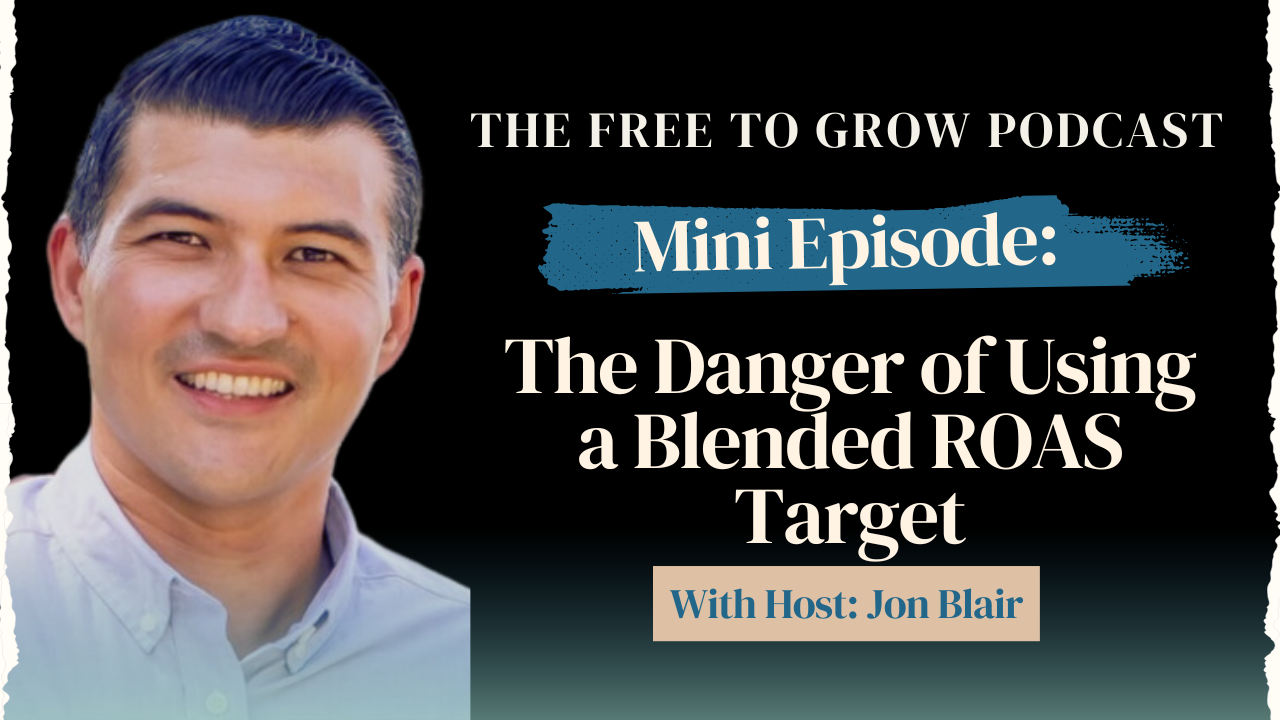Mini Episode: The Danger of Using a Blended ROAS Target
Episode Summary
In this mini-episode of The Free to Grow CFO Podcast, Jon Blair breaks down a common mistake he sees in DTC brand financial strategy: relying on a blended ROAS target to guide monthly ad spend. While a blended ROAS might appear to show healthy contribution margins, it can actually mask losses on new customer acquisition—especially when repeat customer revenue is propping up the numbers.
Jon walks through how to break down contribution margin by customer type and why attributing ad spend correctly is essential for truly understanding performance. This episode is a must-listen for founders who want to scale profitably and avoid misleading metrics.
Key Takeaways:
Using a blended ROAS target can be misleading.
It's essential to separate new and repeat customer contribution margins.
Communicate specific targets for new customer acquisition to ad buyers.
Episode Links
Jon Blair - https://www.linkedin.com/in/jonathon-albert-blair/
Free to Grow CFO - https://freetogrowcfo.com/
Transcript
~~~
Jon Blair (00:00)
Hey everyone, welcome to a mini episode of the Free to Grow CFO podcast. I'm your host Jon Blair, founder of Free to Grow CFO, and today I'm gonna talk about the danger of using a blended ROAS target to guide your monthly ad spend. So I'm coming across a lot of brands who are giving their ad buyer a single ROAS target for the month. They're basically saying, for example, hey I want you to hit a 3 ROAS across the business. And so that may look like, hey, I'm giving you $100,000 ad spend target and I want you to hit $300,000 in revenue at the business level. Now, you may look at your fully loaded gross margin or what we call at Free to Grow CFO, your contribution margin before marketing, which is revenue minus all your variable costs before ad spend. You may look at that and say, 50% of revenue.
So after all variable costs except for ad spend you have 50% of revenue left and if you're blended ROAS is a 3 that represents of revenue for marketing costs, so you take 50 minus 33 you have 17% of Contribution margin which appears profitable at the contribution margin level the danger when you dig in deeper and you split out your contribution margin between new customer contribution margin and repeat customer contribution margin, what I keep finding is that oftentimes brands don't realize how low or negative their new customer contribution margin is. So what effectively is happening is to create that 3 blended ROAS, repeat customer sales, which have a higher profitability because there's little to no marketing spend attributed to them.Those are covering up the inefficiency of new profitability, or in the worst case, complete lack thereof.
And so what is my recommendation? My recommendation is to do what we do at Free to Grow CFO, which is break out your contribution margin into two separate segments. The first segment is new customer contribution margin dollars, and the second segment, is repeat customer contribution margin dollars. How do you calculate new customer contribution margin? You take your new customer sales, which you can pull right out of Shopify, you multiply it by your margin before marketing, which in the example I just went through is 50%, and then you subtract all ad spends. What we do at Free to Grow is we actually attribute all ad spend to new customer sales. Now, is there some ad spend that effectively gets customers to come back and repeat purchase, certainly, but it's usually nominal. And we in our modeling attribute all ad spend to new customer contribution. So revenue times your margin percentage before marketing and then subtract all ad spend. That's new customer contribution, margin dollars.
So what's repeat customer contribution, margin dollars or returning customer. It's returning customer sales times that same margin before marketing, in the example we just went through, 50%, but subtracting no ad spend, because we've attributed that all to new customer sales. And so if you start tracking this on a monthly basis, what you're gonna see is if you even turn a profit on new customers. But what's more important is you're gonna actually be able to look at your new customer ROAS, right, and see what your break even or profitable ROAS is for new customers only. And that's incredibly, incredibly important.
Because what we try to do at Free to Grow, CFO, is help our clients communicate to their ad buyers, hey, I don't want you to just look at blended MER and ROAS. Now we may set some guidance around that, but I want you to look at new customer ROAS and new customer CAC. Because we ultimately want to understand the economics of new customer acquisition versus repeat customer acquisition. This interplay is really important.
I'm gonna be talking about it a lot more on future episodes and in a five minute mini-pod, you know, we can't get into all the nuances, but just know, like, what's the big takeaway from today's mini-episode? Do not give your ad buyer simply a blended full funnel or full sales channel ROAS target, which ultimately reverse engineers revenue and ad spend. Instead, give them a new customer ROAS target and a new customer CAC target and figure out how profitable or unprofitable you need to be on customers.
If that's a daunting task, that's where an e-commerce focused CFO can really, really so anyways, I hope this was helpful. If you're interested in learning more about how we can help with this type of analysis, feel free to reach out to us at FreetoGrowCFO.com and don't forget to check me out on LinkedIn, Jon Blair for more helpful tips about how to scale a profit focused DTC brand.
